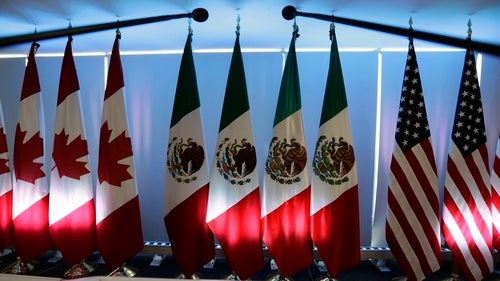The USMCA Is up for Review. What Does That Mean for North American Trade?

As the United States-Mexico-Canada Agreement heads toward its first review in 2026, Julián Ventura shares what’s at stake for the region’s economies.
With the first formal joint review of the United States-Mexico-Canada Agreement (USMCA) set for 2026, the future of North American trade and economic integration is up for debate. In a conversation with the Council’s Christina Colón, Nonresident Distinguished Fellow Julián Ventura discusses the agreement’s successes and shortcomings, how Canada and Mexico are positioning themselves ahead of negotiations, and what a “USMCA 2.0” would need to include to ensure North America remains competitive.
This interview has been edited for length and clarity.
Christina Colón: The United States-Mexico-Canada Agreement (USMCA) is heading toward its first formal review in 2026. What’s at stake in these upcoming negotiations?
Julián Ventura: It's important to keep in mind that the three North American economies represent almost 30 percent of global GDP. It's a huge market and our supply chains are deeply integrated. Over 17 million jobs depend on the trade between the three countries.
The USMCA is the backbone of the economic relationship. It knocks down barriers. It facilitates trade. It makes our supply chains more resilient, which we saw the importance of during the global pandemic. It also strengthens our capacity to compete globally by leveraging the complementarities between the three countries. Certainty is a scarce good in today's volatile global landscape. The USMCA generates precisely the level of certainty sought by investors and by manufacturers.
"Certainty is a scarce good in today's volatile global landscape. The USMCA generates precisely the level of certainty sought by investors and by manufacturers."
The key question is going to be if the three partners are able to come to the table next year with a constructive approach and a strategic vision that addresses those areas in which the agreement needs to be strengthened, updated, or adapted to better address new realities in our domestic and regional economies but still, at its core, continue to offer free and ever more seamless intra-regional trade.
How has the USMCA shaped North American trade? Where has it succeeded and where has it fallen short?
USMCA represented an important shift in the way the three countries looked at each other. There was a tremendous shift in intra-regional trade. Key sectors, particularly the auto sector, became powerhouse drivers of the North American economy. Currently about 5 million jobs are linked to the automobile sector.
There was an increase in foreign direct investment in North America. We saw new, stricter regional content provisions, particularly for cars and auto parts, and new provisions on digital trade, intellectual property, and labor compliance. There was also greater access for the agricultural sector.
We reached almost $1.7 trillion in trade last year, and foreign investment flows have continued to increase with the United States leading the way. Mexico and Canada are now the United States’ number one and number two trade partners, respectively. Last year, Mexico imported more US goods than the United Kingdom, Japan, Germany, Korea, and India combined.
What we have seen, though, is that the benefits of free trade have not reached everyone. This was an important factor in the electoral process that we saw in the United States. There are regional disparities, and workers have been displaced by the transformation in manufacturing. Not all these changes are attributable to the USMCA, but they have made people see the benefits of free trade less clearly.
The renegotiation of the USMCA has, in a way, changed that dynamic by including these new provisions related to regional content and higher wages, and delving into new areas that weren't on the radar when the original USMCA was negotiated. The partners haven’t been as good at developing an ecosystem of local suppliers. This has been significant as we have seen how China's expansion into the global economy has made an impact in key sectors.
It's the core of the USMCA that has been tremendously beneficial, and we've seen the results reflected in the level and the volume of interregional trade and the levels of investment. But the dynamic needs to go one step further. We need to see how we can leverage that legal framework to really make each country in North America a whole lot more competitive going forward.
The upcoming review will be a key moment for all three countries. What do you expect will be the main areas of negotiation?
If the three countries agree that the USMCA should be extended, we’re probably going to see, in general, a push toward greater alignment in key areas. For example, a push to increase rules of origin, to increase the capacity of the three countries to map their supply chains in a more transparent way, and more enforcement mechanisms to see how those regional content rules are being complied with. We're probably going to see a lot of interest in those areas in which the United States feels that Canada and Mexico have a more restrictive approach. This is the case with the dairy and lumber sectors in Canada.
In the case of Mexico, energy has been a recurrent issue of concern in the United States because the USMCA establishes that North American companies should face a legal framework in which there is no discrimination vis-á-vis a state-led energy sector.
We're going to see, perhaps, a push for more agricultural access in a very targeted way. We will see, I think, a push by Canada and Mexico particularly, and by key stakeholders in the United States—which depend on this very liberalized North American trade—to keep USMCA-compliant trade off the books, so to speak, with tariff-free access. Currently, almost 80 percent of Canadian and Mexican exports have tariff-free access to the United States. But there's a whole set of tariffs, particularly those that are related to the so-called IEEPA [International Emergency Economic Powers Act] —emergency tariffs linked to progress on migration and fentanyl—that are currently set at about 25 percent in the case of Mexico.
Section 232 tariffs on steel and aluminum also need to be addressed. The auto sector is partially protected right now because the US components in auto parts and in certain categories of heavy- and medium-weight vehicles are exempt from the higher tariff. The average auto product that is produced in Mexico and in North America has at least 40 percent US content. That's very different from the composition of trade coming out of China. What we make together and what we make it with is going to be a key issue in the negotiation.
"What we make together and what we make it with is going to be a key issue in the negotiation."
Sectorial and emergency tariffs are already part of the discussions. Perhaps those are going to be addressed more assertively in a bilateral way before we head to the trilateral review, but again we will not know where each country is going to stand on the specific issues until they have concluded their public consultation and review processes.
Mexico and Canada appear to be strengthening their alignment. How significant are these closer ties, and what impact could they have on negotiations with Washington?
The bilateral relationship between Mexico and Canada is strategically significant. We are aligned on a lot of issues because we're key stakeholders in the agreement, but the relationship with the United States has different drivers for each. Canada is a US ally in the framework of NATO. Mexico has other drivers related to migration and security cooperation. So, there's going to be some areas in which we will see more of a bilateral dynamic going forward.
There is always talk about whether it's better for Canada to deal with its issues directly with the United States, and not in the North American context. The same with Mexico. I'm someone who believes that we have to work together and align as much as possible in those areas in which our interests are similar or convergent. And in those areas where we don't agree, we must have a very intense level of communication and consultation.
We saw this recently after the change of government in Canada with Prime Minister Mark Carney. Mexican President Claudia Sheinbaum was invited to the G7 Summit held in Alberta over the summer. Prime Minister Carney was just in Mexico a few weeks ago. His visit was preceded by a couple of very important cabinet-level visits. That’s where the countries really started to focus and engage on what Mexico and Canada can do to enhance and increase their bilateral relationship, which also has an important global dimension.
Remember that both Canada and Mexico are part of the Trans-Pacific Partnership and are an important part of the Pacific Rim economy. So, there's room there to cooperate and engage, and at the same time, look at how things are developing trilaterally in terms of the USMCA, and on how we are engaging to address certain issues with the Trump administration so that the level of awareness and trust is as high as possible going toward next year´s review.
That doesn't mean that we're going to be marching in lockstep throughout the process. But the highest level of coordination and consultation is advisable because the two top trading partners of the United States—with very deep ties to the American economy, to the American business community, and to important stakeholders—need to be coordinated to really enhance our footprint and our potential impact in discussions with the White House.
As companies diversify supply chains away from China, there’s growing talk of nearshoring within North America. What would it take for North America to function as a genuinely integrated production hub?
It's not just about eliminating or lowering tariffs on our exports that benefit our supply chains. It's talking about how we can align and modernize our infrastructure, our ports, and our respective borders to give us a better competitive edge in 21st-century trade. To make the movement of goods as easy as possible. To make the movement of services as easy as possible. To create an environment in which regulations are aligned, in which we follow the same or as closely convergent procedures related to foreign investment, regional content requirements, health and phytosanitary standards, and a whole range of other issues that allow our trade to go significantly more smoothly.
China is on everyone's mind because of the size and the projection of its economy, and the impact and level of integration it has with the three North American economies. China is Mexico's third-largest export destination and number two trading partner. To the degree that North America can align as much as possible in those areas where it’s more advisable to have strategic convergence—such as in telecommunications or sensitive infrastructure or critical minerals—that kind of alignment, which gives more certainty and strengthens our capacity to add value to what we produce, is very important.
At the same time, we have to acknowledge the importance of China in our economy and address it in a way in which we can have trade-compliant commerce and investment with China, and with Asia as a whole, in a way that does not weaken but strengthens our manufacturing capacity.
Regardless of the numbers and the hard facts as to what the dimension is of China's relationship with Canada or with Mexico, perceptions are sticky and it's beyond a doubt that there's a strong bilateral consensus in Washington on the need to converge in those areas in which there's a perception that China has become more of a rival and a strategic competitor than a partner. And those areas are going to have to be addressed by the three partners going forward.
What would a “USMCA 2.0” need to include to keep North America competitive in a changing global economy? And do you think there’s enough political goodwill to get there?
In general, there's enough political will to get to a “USMCA 2.0,” but we have to account for a high level of unpredictability. It's no secret that the current US administration has taken a more transactional, unilateral approach to certain issues.
There is greater unpredictability in the way some policy decisions are announced or thought out, and that creates specific challenges for Canada and Mexico going forward. We've seen it over the last few months as we have tried to stabilize our dialogue to the greatest extent possible through very intense interaction with Washington.
If we envision a “USMCA 2.0” that would continue to give certainty to investors and exporters, it would need to have the lowest tariff thresholds possible for intra-regional trade; a strong, credible dispute resolution mechanism; as much alignment on regulations, tariffs, and regional content to foster and not inhibit investment in our economies; and it would need to be able to establish an upward direction in terms of worker training, wages, and other areas in which perhaps the current iteration of USMCA has not been as successful, whether in real terms or in terms of public perception.
A scenario in which we have no agreement or a weaker trilateral approach to these things is going to weaken our overall position globally in a fragmenting global environment. We have a lot of strengths. We can be more competitive, more productive. We can take specific steps to enhance the economic benefits to our three societies. But the jury's out on whether we're going to have a meeting of minds as to the importance of that process.
I'm an optimist. I think, in the end, it's going to happen. But nobody has a crystal ball.
As global trade becomes increasingly politicized, what role could the USMCA play in projecting stability and shared standards beyond North America?
A successful review can have a tremendous global impact.
When NAFTA was negotiated, it was the first time that a developing economy negotiated on equal terms with the world's largest, most-advanced economy. And a successful conclusion of NAFTA, in many ways, triggered dynamics that we saw in Asia, with wide-ranging free trade agreements and associations.
During President Trump's first administration, the world was watching to see if it was really possible to sit down and negotiate successfully with the new administration. I was the ambassador in the United Kingdom at that time and in the middle of the Brexit process, and I can tell you that decisionmakers and stakeholders in the United Kingdom and in Europe were looking at the process very, very carefully.
Canada and Mexico demonstrated that it was possible. The entry into force of the new USMCA in 2020 triggered investment decisions in boardrooms around the world, which became a kind of a preamble of nearshoring dynamics. Because the USMCA came at a time when it was more than evident on a bipartisan basis that the United States was no longer going to engage in negotiations that implied greater market access to its economy, the agreement became the only game in town for companies to invest in and increase their presence in the North American market.
"The way next year's negotiations and discussions play out is going to be looked at very carefully by international trade partners around the world."
The way next year's negotiations and discussions play out is going to be looked at very carefully by international trade partners around the world. They're going to take it into account as they calibrate their respective approaches to Washington. Remember, for example, that the United States has negotiated under President Trump a series of bilateral agreements with the United Kingdom, with Japan, with Europe, with Korea, with Vietnam, and with Indonesia, among others. But those frameworks are very different from what we have in the North American context. They are skimpier on details. They are not legally binding agreements. They can be changed much more easily. They have aspirational investment commitments. We still don't know how some of the partners that have negotiated those frameworks are going to move on the investment front, especially because a lot of investment decisions are made by the private sector and not governments.
With the USMCA and the North American framework, we have detailed rules and procedures and tariff agreements that are binding. Yes, there is a level of uncertainty in terms of the review process that was introduced in the last negotiation, but it's a different kind of critical mass than what we’re seeing playing out in other important economic relationships for the United States. Those countries are going to be looking at very closely at what North America has done and how it's going to address the challenges that we're now facing to gauge the appetite for the kind of framework that we have developed and the Trump administration's approach toward its ongoing trade engagement with the rest of the world.




